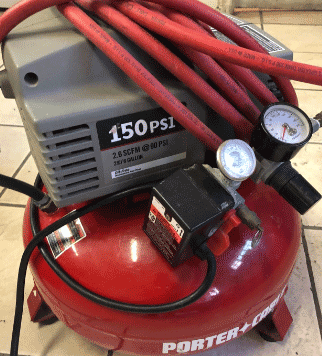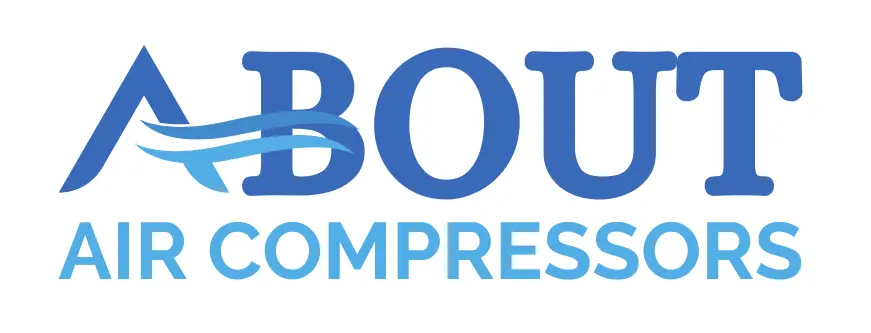Air leaks can be a significant source of wasted energy on Porter Cable air compressors. They will cause pressure drops in the system, as well as resulting in additional costs. This article will provide why your Porter Cable air compressor leaks air, and the most likely locations if you’re looking to diagnose and fix the issue!
Table of Contents
- Why Is Air Leaking From My Porter Cable Air Compressor?
- Useful Pages on Air Compressor Leaks
- FAQs (Frequently Asked Questions)
- Reader Questions & Responses
Why Is Air Leaking From My Porter Cable Air Compressor?
Porter Cable air compressors leak air for a number of reasons. It could be that the fittings are not sealed, the hose or pipe has a crack, or a compromised component that needs replacing. Here’s a list of the most common components that may be causing your Porter Cable air compressor to leak:
- Condensate traps
- Couplings
- Cylinder rod packing
- Disconnects
- Filters
- Fittings
- Flanges
- Hoses
- Lubricators
- Point-of-use devices
- Pipe joints
- Pressure regulators
- Shut-off valves
- Thread sealants
To help you locate your Porter Cable air leak, you typically have 3 methods; listening and feeling, applying soapy water, and using an ultrasonic leak detector. Listening and feeling for air leaks is the simplest method, but not always the most accurate. Applying soapy water to an area where a leak is suspected is a reliable but time-consuming method.
The best method for detecting compressed air leaks is this ultrasonic leak detection, which has quickly become a standard method in the industry. For more information on how to find and fix leaks on your air compressor, visit our guide!
Useful Pages on Air Compressor Leaks
- Compressed Air Leaks – How to Find And Fix Leaks In compressed Air System
- Air Compressor Quick Connect Leaks – Why & How to Fix
- Air Compressor Leaking Air – How to Fix Air Compressor Leak
- How To Fix An Air Compressor Tank Leak
- How To Fix A Leaky Air Compressor Hose – Stop Air Compressor Hose Leaking
- PRVs keep leaking – Air Compressor Pressure Relief Valve Leaking
FAQs (Frequently Asked Questions)
To fix a leaking Porter Cable air compressor, you first have to locate the source of the leak. You then may need to tighten connections, repair or replace components, or swap out the hose or pipe section that is compromised.
Reader Questions & Responses
Porter Cable Air Compressor Leaks Air – Portable Air Compressor Troubleshooting
Question
I have a CGBN125A-3 Porter Cable that has developed a leak and removed the cover to inspect which makes it impossible to run the unit to test for leaks. The hoses look good but did notice the metal tube attached to the cylinder head has a lot of play.
Could that be the problem, says Stan from Hardeeville S.C.
Response
Well, Stan, it’s a bit hard to tell from here. Is air leaking from that fitting? If not, then no, probably not the problem. Makes me wonder how you know that the compressor has a leak?
I’ve tried to find an image of the Porter Cable CGBN125A-3 compressor but have been unable to do so. Perhaps you could upload a photo?
Porter Cable Air Compressor Bleeds Air From Cylinder Head
Question
The compressor comes to full pressure, shuts off correctly then leaks air from a pinhole in the cylinder head near where reed valves are located. Is the pinhole supposed to be there? what is supposed to keep air from bleeding out there?

Response
Mike, once the air compressor shuts off, there is no way compressed air is supposed to bleed out anywhere for more than a second or two.
The tank check valve is supposed to keep the compressed air in the tank until you open a downstream airline to an air tool to use the air. So, if the air is bleeding out anywhere, then I would surmise that the tank check valve is fouled or failed.
I cannot locate a photo of this compressor to confirm it, but here is what I surmise. Assuming that the pinhole is not a structural failure (and I don’t know that) then it may be there simply to bleed air off the cylinder head, may bleed air all the time when the compressor is running but since it’s a small hole, more air goes into the tank when the compressor is running than out the hole.
Then, when the compressor stops, the left over-the-piston air bleeds out the hole, and the compressed air in the tank stays there unless you use it, and unless the tank check valve is wonky.
Porter Cable C7510 60-Gallon compressor Hissing Air Between Cylinders
Question
Ok, you said there were no dumb questions, so here goes.
I have a Porter Cable 60 gallon compressor.
There is a copper line connecting the 2 cylinders. In the fitting into one of the cylinders, there is a small nickel diameter valve – it leaks a short squirt of air with every stroke of the cylinder. It has a small needle that pops out of it. It leaks air from the minute the compressor is activated (even with zero pressure at the start) and continues until approximately 100 psi, at which point it stops emitting air, seals up, and the compressor continues to run until it reaches 120-126 psi and the compressor stops.
I don’t think it takes a particularly long time to come up to pressure and the compressor seems to work fine, but this bugs me. Is this the way this compressor is supposed to work? I cannot find anything about this valve in the parts schematics that I find online. If you are standing in front of the compressor the valve that I am talking about is on the cylinder to the right, ie the cylinder furthest away from the motor. Does anybody have any ideas?
Thanks, Greg
Response
Greg, I’ll take a stab at it, and invite anyone else with this Porter Cable c7510 air compressor to join in.
What I think you are seeing / hearing is the PRV in the line between cylinders. That suggests to me that you are getting back pressure in the line between the two cylinders, causing the PRV to pop open intermittently, and that suggests to me that you may have an intake valve issue on the second cylinder.
Just my 2 cents worth. Anyone else?
If you have any questions regarding a Porter Cable air compressor leaking air, please leave a comment below, with a photo if applicable, so that someone can help you!
